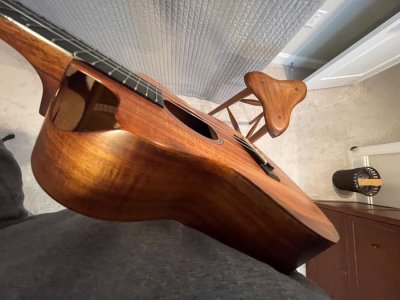I've never played a uke with ONLY a side sound port but it would seem to me that then the audience out front would be hearing only the "recycled" sound, and while it may have enough volume to be heard I have to believe that the sound wouldn't be as clean out front. That said, I'm a huge fan of both front and side sound port. But something I have always wondered about is the effects of the front sound hole when you have the side sound port. To my non-luthier mind, surely when the sound is escaping from 2 holes, it is reduced from the front hole? That leads to a continued thought process of what is the optimal proportion of the sound port to the front hole? I have some ported ukes where the sound port is close in total size to the front hole, and some (especially like the Kanile'a pineapple Platinum with the pineapple shaped port, of Pop's WOW ports which are 3 open parallel lines for ports) that are greatly reduced in total size. I can't hear a difference between these sizes like I can with a ported vs non-ported uke.
Another interesting approach to solving this problem is the LoPrinzi Nova (or Nova Futura and the 1st guitars were called). Augustino LoPrinzi and his brother were New Jersey barbers turned guitar builders back in the late 50's. At some point Augie did an experiment where he laid his guitar on it's back and sprinkled a thin layer of sand on the entire top. Then he strummed the strings and watched where the sand was most active (danced). And it was clearly at the top of the upper bout. That's when he started experimenting with ways to let that sound escape and came up with the Nova Futura guitar. In honesty he took another luthiers concept, the "Thurman Multi-dimensional Sound Port" and refined it into his own design. His thought process was that the traditional sound hole is aimed directly at the instrument's back whereas this new design, opening the sound board and side simultaneously, is aimed diagonally into the lower bout where sound is generated. It is therefore in a very strategic position to liberate and project forward sonic activity moving up from the lower bout. And a side benefit is the port on the "down side" upper bout also functions as a cutaway for playing higher on the neck.
If it sounds like I'm kinda geeked out on this design, LoPrinzi was one of my favorite guitar builders when I played guitar. I've met him and his daughter Donna who now runs the guitar/ukulele shop in Clearwater FL. (how he got started in ukuleles after 25 years of guitar building is another great story for another time). I never owned a Nova Futura guitar but I've owned two of his Nova Ukes, spruce/mahog and all koa (still have the all koa and it's one of my regular players). I believe there's other owners here who have write-ups of their "Augie" Nova's. I believe Donna is still making this model. Here's some pics (last is the players view)








